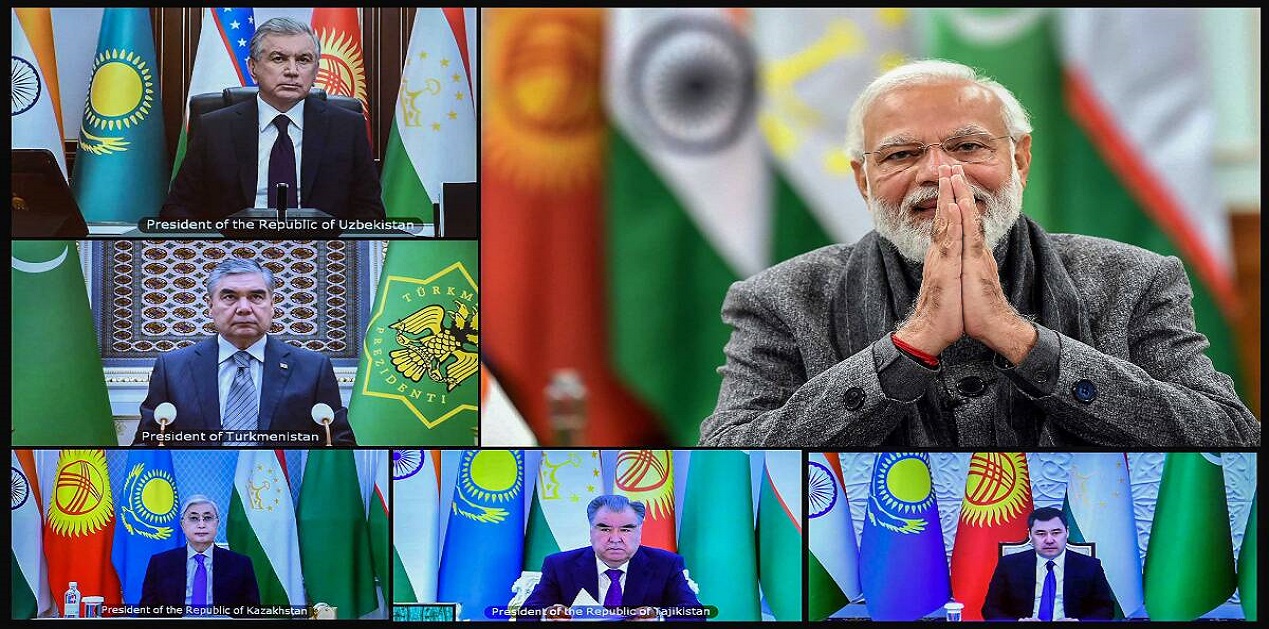On January 27, 2022, India and Central Asian leaders held the maiden India-Central Asia Summit in a virtual format. The summit was hosted by Indian Prime Minister Narendra Modi and attended by the Heads of State of the five Central Asian countries. [1] This summit is significant for two main reasons; first, India and Central Asia have completed thirty years of establishing diplomatic relations in 2022, and secondly, the rapidly changing regional environment in South and Central Asia. Following India’s announcement of the India-Central Asia summit, China convened a virtual meeting with the Presidents of Central Asian countries on January 25, 2022. Chinese President has offered 500 million USD in assistance and pledged to boost trade with these countries. [2] China's approach might be interpreted as a response to India's initiative, despite the fact that China already has a dominant presence in the region.
India’s relations with Central Asian countries have gained momentum in the recent past due to a revitalized Central Asia policy adopted by New Delhi and an active approach to enhance India’s footprint in the region. India and Central Asia Summit is another achievement of India’s Central Asia policy in recent years. On the completion of the summit, the ‘Delhi Declaration’ was adopted. Some major highlights of this document are analyzed below.
Establishment of India-Central Asia Centre
India proposed establishing the India-Central Asia Centre in New Delhi, which will operate as the secretariat for the India-Central Asia Summit. In order to assess and analyze the issues and prospects of India-Central Asia relations, this centre might work as a nodal point for multilateral cooperation.
India-Central Asia Parliamentary Forum
All the leaders expressed their readiness to create an India-Central Asia Parliamentary Forum to enhance the cooperation between the parliaments of India and Central Asian countries. [3] Being the largest democracy in the world, India has a lot to contribute to the reforms and developments of CARs in terms of legislature and governance.
Focus on Cultural and Civilization Linkages
India and Central Asia share close cultural and civilization linkages, but there has been a lack of focus on this issue from both sides. Considering the importance of the historical ties, all the leaders agreed to hold regular meetings between the culture ministers to advance the cooperation in this area. In order to celebrate the linguist similarities between Indian and CARs, India proposed to commission a ‘Dictionary of Common Words used in India and CARs’. Furthermore, organizing a Buddhist exhibition in CARs will showcase the deep Buddhism linkages between the two regions.[4]
Security Cooperation
Afghanistan remains a common concern for both India and Central Asia. Prime Minister Modi has stressed the importance of Central Asian countries to the security and stability of the region. Taking note of the success of the ‘Delhi Security Dialogue on Afghanistan’ held in New Delhi in November 2021, India and Central Asian leaders agreed to continue the regular meetings of the secretaries/NSAs of the Security Council to discuss the development in the region. Uzbekistan will organize a ‘High-Level International Conference on Afghanistan’ under the auspicious of the SCO in July 2022 in Tashkent. The establishment of a Joint Working Group (JWG) on Afghanistan will give an institutional framework to the joint efforts of India and CARs to stabilize Afghanistan.
India and Central Asia share similar views on terrorism and extremism as the main threat to regional stability. Therefore, enhanced cooperation in fighting the conventional and the novel practices of terrorism and extremism, i.e., cyber warfare, is a prerequisite. Terror financing is another challenge for both India and Central Asia. Tajikistan’s proposal to hold an International Conference within the framework of the ‘Dushanbe Process on Countering the Financing of terrorism’ in 2022 in Dushanbe will be a significant step in this regard.[5]
Pandemic Cooperation
The collaboration during the Covid-19 pandemic has been a fine example of the India-Central Asia cooperation in health sector. Indian Prime Minister emphasized on ‘One Earth One Health’ approach to ensuring equitable and affordable access to the critical health supplies that the Central Asian leaders also hailed. The smooth transportation of medical supplies is crucial in fighting the pandemic like Covid-19. Therefore, UN General Assembly Resolution A/RES/75/313, which Turkmenistan initiated to strengthen the links between all modes of transport to ensure stable and reliable international transport for sustainable development during and after the Covid-19 pandemic, is an important measure to note.
Capacity Building and Human Resource Development
The Central Asian leaders commended India’s assistance in human resource development and capacity building in CARs. India offers the highest numbers of Indian Technical and Economic Cooperation (ITEC) slots and Indian Council for Cultural Relations (ICCR) scholarships to the youths of CARs which can be increased and customized as per these countries’ requirements. India also offered to provide professional training programmes to the diplomats from the CARs, which will substantiate institutional cooperation and enhance people-to-people contact.
Trade and Investment
India and Central Asia trade is below the potential, requiring concerted efforts from both sides to eradicate the challenges. The leaders noted the efforts of the India-Central Asia Business Council (ICABC) to develop the investments opportunities between India and Central Asia. During the summit, it was also proposed to create an ‘India-Central Asia Investment Club’ under the auspicious of ICABC to enhance and promote the opportunities in this sector. Both sides also identified multiple sectors like agriculture, energy, textile, pharmaceutical, education, IT, business process outsourcing (BPO) to enhance trade and investments. The cooperation between the states of India and Central Asian countries on the lines of the Gujarat-Andijan partnership can be developed. A road map for enhancing industrial cooperation and bilateral trade is considered to be an urgent need by both India and CARs.
Connectivity
Connectivity projects like Chabahar ports, International North-South Transport Corridor (INSTC), Ashgabat Agreement, require priority consideration and could be a force multiplier for trade and economic cooperation between the two regions. The integration of the Chabahar port into the INSTC is supported by the CARs. Turkmenistan also offered to include the Turkmenbashi port within the framework of INSTC, which will give impetus to the connectivity initiatives. As proposed, a Joint Working Group on Chabahar port will help identify and address the issues related to the trade and economic cooperation between India and CARs.
Education, Health and Tourism
The cooperation between education institutions is an important measure to enhance awareness among the population of India and CARs. Indian universities are operating in Uzbekistan, which has been acknowledged by the other Central Asian leaders as well. India also proposed to host 100 members of a youth delegation from Central Asia every year, which will develop a greater mutual understanding between India and CARs. Leaders from Central Asia have stated their desire to assist in the establishing of Indian medical and diagnostic centres in their countries. In the tourist industry, there is also a lot of potential between India and CARs. Indian Films and Television industries are very popular in these countries that can be utilized as a multiplier of tourism promotion. The CARs are keen to have Indian films shot in these countries’ beautiful locations. On the other hand, India has lots of potential in developing tourism infrastructure in the CARs. Uzbekistan will organize the 25th session of the General Assembly of the World Tourism Organization in 2023 in Samarkand, where interested Indian industries would be invited to participate and explore the opportunity in this sector.
Defence and Military Cooperation
India and CARs hold bilateral military exercises at regular intervals. Holding joint counter-terrorism exercises between India and interested CARs will further advance the security cooperation between them. Execution of joint military production is crucial; however, there was no mention of it in the Delhi Declaration.
Sustainable Development and Climate Change
Both India and Central Asia share climate change and related concerns. Both sides pledged to reduce carbon emissions and develop the means of alternative energy resources. However, there is more scope for collaboration in disaster management and green recovery.
Conclusion
India Central Asia Summit will advance India’s developmental and strategic partnership with Central Asia. As agreed by both sides, the summit will be held at an interval of two years. The next meeting will be held in 2024. In the meantime, both India and CARs must assess and analyse the developments as proposed in Delhi Declaration. Some important initiatives suggested in this summit, such as JWG on Chabahar port, India-Central Asia Investment Club, regular meetings between Trade and culture ministers of both regions, will be helpful for the growth of India-Central Asia multifaceted relations.
Endnotes :
[1] India-Central Asia Virtual Summit, PIB Release, Ministry of External Affairs, Government of India, released on January 27, 2022 URL: https://pib.gov.in/PressReleasePage.aspx?PRID=1793068
[2] Almaz Kumenov, China promises more investment at Central Asia summit, Eurasianet, released on Jan 26, 2022 URL: https://eurasianet.org/china-promises-more-investment-at-central-asia-summit
[3] Delhi Declaration of the 1st India-Central Asia Summit, Ministry of External Affair, Government of India, released on January 27, 2022 URL: http://www.mea.gov.in/bilateral-documents.htm?dtl/34773/Delhi_Declaration_of_the_1st_IndiaCentral_Asia_Summit
[4] ibid
[5] Ibid
(The paper is the author’s individual scholastic articulation. The author certifies that the article/paper is original in content, unpublished and it has not been submitted for publication/web upload elsewhere, and that the facts and figures quoted are duly referenced, as needed, and are believed to be correct). (The paper does not necessarily represent the organisational stance... More >>
Image Source: https://images.indianexpress.com/2022/01/FotoJet-57-1.jpg











Post new comment